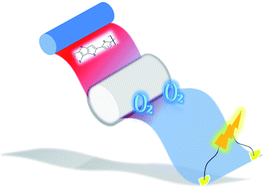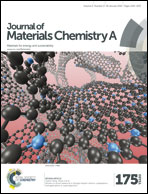Two soluble polymers with lower ionization potentials: doping and thermoelectric properties†
Abstract
Doping and thermoelectric properties of two solution-processable conjugated polymers with low ionization potentials (IPs) have been studied and compared. An optimized thermoelectric power factor (PF) approaching 40 μW m−1 K−2 at 390 K was achieved in films of polymer PDTPT-C12, by performing doping treatment with LiTFSI solution in air, while an optimized thermoelectric power factor around 12 μW m−1 K−2 at 390 K was observed when CuTFSI2 solution was used instead of LiTFSI. In contrast, such effects on thermoelectric performance as a result of dopant species were not observed in the other studied polymer PTVT2T-C12 with comparable IP. Based on the results of thermoelectric measurements and optical spectroscopy as well as photoelectron spectroscopy, the role of Li+ in the resultant thermoelectric performance was proposed. Moreover, owing to the relatively low IPs of the two studied polymers, the as-doped polymer films are reasonably stable under ambient conditions. Therefore, N-alkyl dithieno[3,2b:2′,3′-d] pyrroles (DTPs) as exemplified in the case of PDTPT-C12 are suggested to be promising building-blocks and the incorporation of small cations like Li+ may be an alternative to increase the thermopower in solid state devices.


 Please wait while we load your content...
Please wait while we load your content...